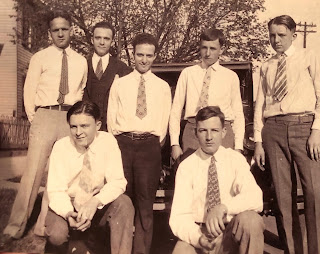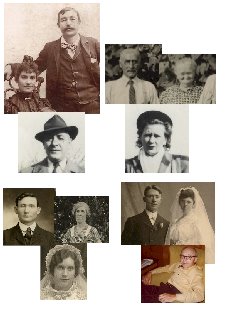The Connaughton and Hodapp Families
 Margaret & William Connaughton Wedding
Margaret & William Connaughton Wedding
Patrick Connaughton - approx: 1819-1877 (William Sr.'s parent)
Anna Flatley - 12/15/1834 - 2/27/1917 (William Sr.'s parent; emigrated 1860 or 1862)
Children:
Michael; b. 7/1870
William; b. 5/12/1871
Bessie (aka Bridget); b. 3/9/1873 - 4/26/1958
Mary; b. 3/25/1876 (or 3/12/75) - 4/17/1916 (nun) | William's Children:
Bob (b. circa 1906)
William (b. 1908)
Ed (b. 1910)
Mary (b. 1913)
John (1916-1917)
Ruth (b. 1920) |
Tom C. (1938 - 2/1/2011)
Bill C. (11/14/1941 - 11/17/14)
 <--Patrick's son William Sr. with wife Mary; 1906 wedding
<--Patrick's son William Sr. with wife Mary; 1906 wedding
The first Connaughton (Ó Connachtáin) relative we know of was Patrick (the father of William Sr.), born in Ireland around 1819 (according to "Butler County Ohio Death Records 1867-1880"). From his son William's death certificate we learn that he was born in County Roscommon. Patrick became a US citizen on 10/12/1866 in Hamilton in the Probate Court of Butler County and he and Anna Flatley (or Flattle or Flattry or Flaherty...) were married 8/13/1868 in Hamilton when Anna was 34. They were married by Rev. Hone at St. Mary's. (Hone was something of a Hamilton legend as shown by The Telegraph article: "Last Tuesday Rev. Chas. Hone, who had been for many years the pious, faithful pastor of St. Marys Church, Hamilton, was laid to rest in the presence of his sorrowing congregation and hundreds of Protestants who revered this worthy priest for his many virtues. The funeral was the largest demonstration of public respect ever witnessed in Hamilton." See Jim Blount column for more info on early history of Catholics in Hamilton.) According to records at familysearch, Patrick died at age 58 of tuberculosis, while living in Hamilton's 2nd ward. From Wikipedia: "Tuberculosis, or 'consumption' as it was commonly known, caused the most widespread public concern in the 19th and early 20th centuries as an endemic disease of the urban poor." He was listed as a laborer and his obituary (Butler County Democrat dated Nov. 15,1877) mentions that he was working for the Cincinnati-Hamilton-Dayton (CHD) railroad at the time of his death. (St. Mary's Cemetery, sec B, lot 13-West, grave A, which is associated with St. Mary's church.



Found on the Internet, a family memoir from a Stephen Connaughton of Dublin, Ireland:
The Connaughtons, according to a medieval map, hailed from that corner of County Sligo next to Kilalla Bay. There is an oral family tradition that some of them joined up with General Humbert’s French army when it landed at Killalla in 1798, in an attempt to rid Ireland of the English. Humbert was successful at first, routed English forces at Castlebar, and set up the Republic of Connacht. However he was eventually defeated by Lord Cornwallis - he of American War of Independence fame. The Connaughtons, having backed a loser, now could not return home for fear of their lives, and settled in County Roscommon. It is still a common name there. One of their number settled in Marlesgrove, Ballymoe, and it was from here that Dad’s grandfather, Patrick Connaughton came, when he married into the farm at Cournabanny, Cloonfad in 1869. Dad and I often discussed family history working in the fields during my teens.
_________________________________________________________________________________________________________________
A Theory Concerning Patrick Connaughton
We know very little about Patrick Connaughton, but there's one tiny clue: the grave of a "Josephine Connaughton" is right next to his wife Ann's. One theory is that Josephine was William Sr.'s first wife. Another is that she's Patrick's niece. (Update: There are records of a "Mrs. William Connaughton" dying in 1900, making it less likely that Josephine is his first wife.)
Josephine Mary Connaughton died at the age of 25 in 1901. Her grave is next to Ann's.
One Possible Patrick Connaughton Timeline:
1819 = ? birth in Ireland
1811-1840 = ? at some point emigrates (age 1-30)
1840? - 1/5/1840 marriage to Bridget in Butler County, Ohio according to familysearch.org. (St. Stephen is only Catholic Church at the time; no baptismal records of Connaughtons through 1850)
1854? - 5/25/1854 marriage to Ann Burnes in Butler Co. Ohio.
1861-1868 = ? first wife (Bridget) dies (she would be btwn 41 and 48 yrs old)
1866 = Patrick for sure in Hamilton, becomes U.S. citizen (he's 47)
1868 = marries Anna (he's 49, she's 34)
1870= Patrick & Anna not on 1870 census;
1877 = Patrick dies (he's 58).
1880 = Anna appears on census with her kids, lives on Hanover Street in Hamilton. She's been unemployed 3 of the last 12 months as laundress but is able to support herself, presumably since Patrick had been well-established before his death.
__________________________________________________________________________________________________________________
Ann was born in County Mayo and emigrated to America in either 1860 or 1862 (1880 census has the latter), having survived the famine (she would've been 12 in 1846) and according to the census being unable to read or write English. According to the Griffiths Valuation in 1856, her father William Flatley might've had owned land in Mayo in either Bekan or Knock or Kilmovee. Kilmovee also had a Nolan (William's wife's maiden name) landowner.
Four years before her death, Ann was said to have put a curse on her grandaughter, William's infant daughter Mary, because she wasn't named after her. (Interestingly, her mother was named Ann but not any of her surviving children.) Mary had diabetes but was saved by a new drug on the market - insulin. It's something of a mystery how Ann, a laundress with no education, could raise at least three children on her own. Patrick must've left her money? At the time of the 1880 census she is widowed, living on Hanover Street near 2nd Str and was unemployed for 3 months out of the past year.
She died 2/27/1917 (St. Mary's cemetery Sec A, 20-East, Grave D), a widow for forty years. (Obituary here. According to the death certificate, she died while living at 273 Hanover, right next door to her son William (275 Hanover), though the county auditor shows 275 built in 1900 and 273 in 1920.) - 1880 census
- 1880 census
___________________________________________________________________________________________________________________________
Children of Patrick & Ann
Michael Patrick Connaughton (William's brother in above census) was born 1/10/1870 (Miamisburg), died 12/2/1938.
He was the eldest son of Patrick and Ann Connaughton, a 5'8'' blue-eyed, dark-haired 28-year old man when he volunteered to serve in the Spanish-American War. He was a member of the Sixth U.S. Infantry Company E, a member of the "Sixth Immunes", called that because they were supposedly immune from yellow fever.
From the book
Hamilton in the War of '98:

Private Michael P. Connaughton enlisted in the Six U.S. Infantry at Ft. Thomas, Kentucky, May 27, 1898. He was in the Santiago campaign and tells many interesting experiences. Referring to the battle of San Juan, he wrote:
"Reveille sounded at 3:30 o'clock next morning, July 1st, and we started for Santiago at 4. We were put on fighting line and were given a rest before going to the front. The blanket rolls were discarded about half a mile from San Juan Hill and we marched forward to take our place in battle. It was a hard fight. The bullets cut the grass all around us but we continued going forward until we reached the San Juan River, which we crossed. It was shoulder deep; but the worst had not yet come. A heavy barbed wire fence had to be cut away, but the gallant Sixth was equal to every emergency. Imagine how, when we saw the Spanish on the Hill, those wires were cut and the charge up the Hill was begun. Captain Kennan of Company E, one of the bravest and coolest men I ever saw, accompanied by sixteen of his men, including myself, were the first on the Hill. Other regiments claim that honor for themselves but the Sixth was undoubtedly the first."
Private Connaughton said that he stood about three yards from the first soldier killed in the battle, Private Butler of Connaughton's own Company.
Over 35% of the men of his company were killed in that battle. Captain L.W.V. Kennan served under Lt. Col. Henry Egbert, who served under Gen. Hamilton Hawkins. More
here and
here.
Connaughton, along with another Hamilton soldier, was honored with an engraved gold badge in October (presented along with the song
Break the News to Mother by a local glee club): "Those who were given places on the platform were: Privates Kienzle and Connaughton; Mrs. Kienzle and Mrs. Connaughton; Misses Nettie Kiezle and Anna Connaughton..." Was the Mrs. Connaughton his mother or his wife? In 1898 I didn't think he was married.
On 10/14/1903, he married for the first time (according to a later census) at age 34 to a woman who had gotten married seven years earlier at the age of 20. How her first marriage ended is not known, but she produced at least six children with Michael, five of whom survived to adulthood. Their kids were: Francis, Charles, Mark, James, Catherine and Mary. (Mary was a religious sister who was originally named Mary C. Connaughton (not to be confused with another Mary Connaughton who also became a nun, namely the aunt of this Mary Connaughton).

Mary C. Connaughton, or Sister Mary Jarlath R.S.M., passed away 10/28/10 at the age of 94. From her obituary:
Sister Mary Jarlath Connaughton was born in Hamilton, Ohio. It might have been the fact that she grew up with four brothers that inspired her love of sports. Her friends spoke of how she excelled in softball and basketball, surprising for a young woman in the 1920s. She entered the Sisters of Mercy in 1936 and was one of our last sisters to have made her novitiate in Dubuque, Iowa, where, she said, “they used to ramp around the lake.”
Sister Mary Jarlath began her teaching ministry in elementary school, then moved into high school for most of her career. She taught science, theology and Problems of Democracy in high schools in Piqua and Urbana, Ohio and at McAuley High School in Cincinnati. She ministered in pastoral care at Mercy Medical Center in Springfield, Ohio, from 1974-1980 and again from 1985-1992 when she retired to McAuley Convent.
Perhaps it was her interest in sports that accounted for her appeal to her students, especially boys. She was well loved as a teacher, always had a group 3+ # of students around her and was held in high regard by the patients to whom she ministered in pastoral care.
Sister Mary Jarlath loved ice cream and chocolate; she had a collection of stuffed animals. When she was more able to communicate she had beautiful relationships with her nieces and nephews, and with her grand and great grand nieces and nephews. Her retreat notes list a few of the virtues that were important for a Christian and a religious woman—patience, compassion, amiability, gentleness—all virtues that she possessed to a great degree.
___
A native of Hamilton, Sister Mary Jarlath, entered the community in 1936 and professed her final vows in 1941. She began her ministry as a teacher in elementary schools, and then moved into secondary education. Sister Mary Jarlath’s teaching assignments included the former St. Mary School in Urbana; the former St. Mary School in Piqua; and Mother of Mercy and McAuley high schools in Cincinnati. She also ministered in pastoral care at Mercy Medical Center in Springfield from 1974-1980 and 1985-1992, when she retired to McAuley Convent.Interment was in St. Joseph (New) Cemetery.

Mark P. Connaughton was particularly gifted academically. He was one of four to give addresses at Hamilton High graduation ceremony due to scholastic excellence. The
Hamilton Evening Journal re-printed his address in 1930
:
One of we Americans' greatest national characteristics today is an overwhelming pride. Pride in ourselves and in our beloved country. To an American we are the greatest people - this, the greatest nation the world has ever known. We glory in our national resources which God in his mercy has given us. We are proud of our success in war and in peace, our skill in government, and our progressive spirit, which has wrought almost a miracle of development in the last century. We know that we occupy the center of the world's stage - the greatest experiment in representative government in the history of the world. Today it is to a tune of our playing that the world dances.
It is true, we oftentimes sing our own praise with more enthusiasm than good taste, but self-confidence based on reason and a healthy optimism can hardly be disastrous to a nation. Yet it is true that this pride of ours is the source of some evils which should be and are attacked. Such pride is liable to cause us to be slow to take action against abuses which concern us, and indifferent to those which do not. Reformers rise up from time to time and point out the evils of our way, the gulf of ruin yawning for us if we continue in such paths. But the majority of our citizens heed such warnings not at all.
What is the true test of a nation's greatness? Is it wealth? Yes for wealth makes possible hospitals, schools and churches and the other institutions so essential to our modern world. Is it prestige amongs the nations? Undoubtedly, for power breeds self-respect and a sense of responsibility. Is it general well-being? Certainly, for a nation, and more particularly a representative country, depends on the individuals who go to make it up.
One great Grecian philosopher expressed these words of wisdom, "The greatest of a state is in proportion to the loftiness of the ideals of its citizens." Today this old Greek's standard has been replaced by our modern standard of a nation's greatness. A country's power in war, the volume of its commerce, and its wealth, those are the modern standards. Yet those who think realize that there is great truth in that Greek philosopher's words. His is the standard, not of material greatness, but of moral greatness, and if the religious teachers do not err, this is to be more desired than the pomp and and power of kings.
How does America check up when measured by this standard? Is this talk about "commercialism" and the "almighty dollar" all bosh? Is it the worn-out notions of old fogies who are out of step with our modern civilization? Or is it the complaint of the incompetents and failures who thus seek to solace themselves for having failed in the climb for success? Or is there truth in it? Let us see. Let us visit all the cities and towns of our land. Let us go to the great manufacturing and trade centers of the east, with their teeming millions. To the great cities of the fast-growing west, to the farming centers of our middle states. To the hamlet and village of the north and south- everywhere - we find that a new worship has crept into the hearts of our fellow-citizens. The worship of material success.
However, it is not my intention nor is it at all necessary to recall to you the conditions into which this worship, as it were, has thrown the nation. We have only to look around in order to see the injustice, the oppressiveness, the total inhumanity which is so evident in our business world of today.
Petty fraud and small deceit, a little lie where a truth wouldn't serve as well, these seem prime necessities in the business world today. Everywhere we see signs yet we hear "business is business" from all sides. Apparently business and morals have no connection whatsoever.
Not so. Many there are, a goodly number, in this great country of ours, where oft times the battle of business wages so fiercely, that some forget the rules of combat who will not abate one bit of their high ideals, in their fight for success. They would be successful, yes, but not at the price of their ideals. Truly we need not fear the loss of our nation's place in the world of business.
But let us not seek to deceive ourselves. If we look the situation squarely in the face we must admit that these men of ideals, who hold to their ideals, are not in the majority.
What is to be done? How can this theory of "success at any cost" be combated? Science has done some wonderful things in our time, but science has never yet produced any mechanical device which will change the moral fiber of a nation. Whatever change comes, must come thru the realization by individual men and women that ideals are distinctly worthwhile. And it is of vital importance that our young men of brains and power, our future leaders, understand this truth thoroughly. And where can this best be taught? There is no better place in the world than our own Catholic educational centers. The love of absolute truth, the appreciation of other than mere material gain, the fearlessness of strong convictions are in the very atmosphere of our schools. Most readily within their bounds, high standards become usual, ideals, but commonplace. The Catholic colleges and schools have always been the teacher of those ideals, which are so essentially connected with a nation's greatness. Herein lies the noblest function and the fairest promise.
Throughout the land, the fight for purer government and for higher citizenship is being led by men with a background of good Catholic education and training. In every community there are amongst the moral aristocrats, a great number of these with whom idols have not replaced ideals.
May our Catholic high schools and colleges continue in the future as they have in the past to train our youth to know high standards and to live up to them, to hate a cowardly compromise and despise a lie so that the term "Catholic education" will always stand for high ideals, for fighters who prove that material success is not the supreme deity amongst we Americans, that the pocketbook is not the symbol of national devotion, nor the dollar mark the seal of our greatness.
Mark P. went on to graduate from U.C. as a geological engineer and died in Washington D.C. in the early '90s. During the '40s he authored some works while working for a Soil Conservation agency.
Bessie lived into her 80s, living with her mother and never marrying. Not much else is known about her. There's a record of her donating to the Knights of Columbus War Fund (WW 1) in 1917, of approx $20 in today's dollars. In 1925 we read that she spent the 4th of July at Indian Lake. Later that same year she vacationed with relatives in Philadelphia and Atlantic City. In 1926 she hosted a bridal party with Margaret Connaughton for a Kathryn (Marshall) Renneker.
 Mary A.
Mary A. Connaughton became Sister Marie St. Joseph of the
Sisters of Notre Dame (a 1900 history
here and more
here). She became a novitiate on 4/30/1899 and entered the convent on 8/18/1901 (
at Sixth Street, Cincinnati) and was at the
school ("Mt. Notre Dame Ladies' Literary Society" on the census) in Reading by 1910. She died before her mother, on 4/17/1916 at the age of 40. She is buried at the Mt. Notre Dame Cemetery in Reading.

(
From The Republican
newspaper, Hamilton, Ohio, Monday, August 13, 1894.)
William was born in Miamisburg, near Dayton in 1871. Ann Flatley and Patrick moved back to Hamilton in 1872 or 1873 when he was one or two years old. Of William's siblings we know of Michael (born June 1870), Bridget (or "Bessie" - born 3/9/1873, died 4/26/1958 and never married) and Maria (born 3/12/1875, died > 1880). William married Mary Francis Hodapp (1875-1952), whose parents were Andrew Hodapp (1842-1928) and Anna Mary Schillinger (1843-1930). They were married 5/15/1906 by a Rev. J. St. Holthaus at St. Joseph's, the German parish where the Hodapp's went, rather than the Irish parish William's mother belonged to. (Holthaus later the
founder of St. Ann's parish in Hamilton.) From Margaret C:
"Mary Hodapp was William Connaughton Sr’s second wife. William was best friends with John Moore. When John Moore was married, William was in his wedding along with Louise Hodapp's sister Mary. That is how William met Mary. His first wife died of pneumonia sometime before 1906."
We think Josephine Mary Connaughton, who died in 1901 at the age of 25, is William's first wife. Their child William is my grandfather and his siblings included Bob, Ruth, Mary (11/25/1913 - 3/29/1981), and Edward (12/23/1910 - 1/28/1973).
Between 1904 and 1908 William worked as a deputy under this Butler County
sheriff, the highly respected
Luke Brannon. Some of his duties are shown in these images:
He later worked for
53 years at the
Estate Stove Company (
then &
now), first as a moulder. Is he in any of the following photos? He would've been 36 years old this 1907
photo, 49 in this 1920
one, 56 in this '27
photo, 60 in this '31
one. William is buried at St. Stephen's Cemetery & his sister Bessie are buried in the Hamilton cemetery St. Mary.

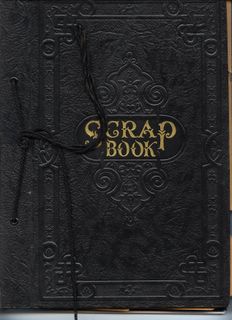
(Photo of Grandma's scrapbook) |
Scrapbook Images
Here are scanned images of stories and photographs from the scrapbook of Margaret Connaughton concerning the Cogan & Connaughton families:
Obit of William Connaughton Sr. (continued here) His house.
Wedding engagement of Margaret Cogan to William Connaughton Jr.
Wedding announcement one & two of Margaret Cogan to William Connaughton Jr. at St. Patrick's
First Mass of Edward Connaughton (son of William). Rest of article here. A 1972 sermon. Photo.
Obit of William Connaughton Jr. (my grandfather) Rest here. Photo here.
Poem written about Cogan farm
Funeral sermon for Thomas Cogan Sr.
Newspaper photo of Mary Alice Smith (daughter of William Connaughton Jr.)
1940s photo of of Margaret Connaugton holding son Jim and Mary Francis (Hodapp) Connaughton holding her grandchild (Ruth's child Kathy)
|

Grandma's wedding:
___________________________________________________________________________________________________________________________
More Connaughton Family Photos
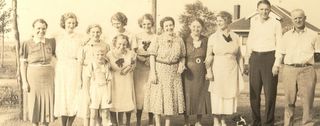
(click to enlarge) second from left Edward Connaughton, forth from right his mother Mary Francis, fifth from right Mary Connaughton

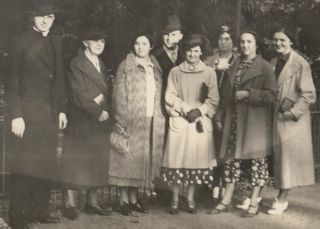
going to the zoo in '42; (click to enlarge) - From left (Ruth, her friend, Margaret Connaughton, Marcella Moore, William Connaughton, Mary Connaughton, Mary Francis, Edward Connaughton
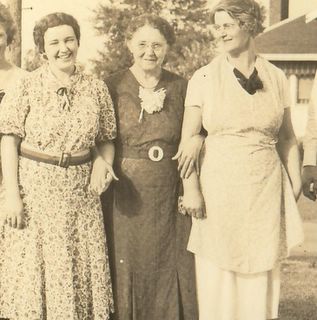
Mary Connaughton at left, her mother (Mary Francis Hodapp) in the middle
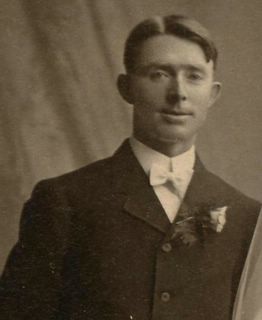
Great Grandfather William Connaughton
1925-1935 era photos:
Louise Moore, Katie Beimesche, Mary Connaughton, Helen Hodapp
"Four generations": Andrew and Anna Hodapp (82/83 years old; seated), Aunt Katie and Uncle Gus Beimesche (53/61 yo), 25 y/o Helen & Charles Lang & baby Charles born 1925.
Louise Moore, Katie Beimesche, Mary Connaughton
"First cousins": Charles, Paul & Francis Moore, Don Hodapp, Ed Connaughton (standing right), Bill Connaughton (squatting, left), Harvey Hodapp
___________________________________________________________________________________________________________________________
From Margaret Connaughton (wife of William Connaughton Jr, my grandfather):
"When I was in my teens we drove a horse and buggy to Wapakoneta, but later we got a model T Ford, the kind you had to crank to start the engine. I drove all kinds. Also I remember going to town of St. Mary's (5 miles away). The passenger train stopped at Glynnwood.
Your Mom was very close to aunt Mary and Ed [Connaughton - sister and brother of William]. Mary was close to our family. I really liked Bob, your great uncle. He was a very kind person, very charitable. He died very sudden of a diabetic coma. He did become an alcoholic. He was going with a very nice girl, but because of drink she wouldn't marry him.
About my wedding day - Tom Byrne (Fr. Jim's brother) got a buggy out of the barn chained it to his car and took us in it, along with any guests that wanted to go, on a trip to St. Mary's (5 miles from Glynnwood), through the main street to a saloon at the end of the street. There we were put up on a table and all the guests sang a number of songs and drank beer. My brother-in-law Bob paid the bill. I'm sure my father-in-law liked that part. Some of the guests (from Cincinnati) didn't trust "that Irishman") and didn't go. I am sure Tom Byrne had it pre-arranged. We were also to be put in jail, but that fell through. That was part of our "reception". There was no music or dancing in those days."
Grandma Margaret worked at the rectory of
St. Joseph's for her uncle, a priest, before she was married. She found it very hard moving to Hamilton and leaving her family in Auglaize County behind. In those days transportation was harder to come by and she saw her family only once a year for the next two decades or more. Coming from a Irish background, her standard of a clean house was different from her more fastidious German in-laws. (The stereotype was shown by how cobwebs were then called "Irish lace".) One time her sister-in-law picked up a glass and asked whether she should trust whether Margaret had cleaned it thorougly. Back then, there was still tension between those of German and Irish heritage.

Mary Francis Hodapp | William and Margaret Connaughton loved to vacation every year at a cabin near Lake Michigan. William worked at Mosler Safe Company in Hamilton and liked woodworking. During retirement, he made his older grandchildren beautiful wood safes. Both he and Fr. Edward died suddenly, of a heart attack and stroke respectively, but both seemed to have their affairs in order. About two and a half months before William died he said the he was "ready to leave this old world. I've had a good life." |
10-yr old William Connaughton at St. Mary's School in 1918?
Fr. Ed was called a "saint" by Fr. James Byrne, saying he put up with an awful lot without asking to be transferred out of a tiny room in downtown Dayton. (He was assistant superintendent of the Dayton parochial schools.) He wrote:
Connaughton, Father Edward A., A History of Educational Legislation
and Administration in the Archdiocese of Cincinnati, Washington,
D.C.: Catholic University of America Press, 1946. 213 pages
A priest who served from his ordination in the late ‘30s till his death in the early '70s, as children we knew him as a tall, authoritarian figure. And yet there’s a picture of him in an old photo album, shirtless, with a mustache a ringer for Clark Gable, on a fishing trip in the ‘40s. It was said his first love was the outdoors. His second love was a parish of his own. And the priest who gave up most of his outdoors time was too good an academic and the bishop assigned him to overseeing and studying Catholic schools, concerned that in the future only the rich would be able to afford them. He disliked the administrative job, but did it uncomplainingly, confiding only in his sister. He finally got his wish of being a simple parish priest at
St. Mary (picture
here) in Franklin, Ohio, from 1971 to his death in 1973.
We have a 1972 tape of a homily he was practicing in preparation for Fenwick High School’s Class of 1972 Baccalaureate Mass. In the background plays instrumental music from the musical
Fiddler on the Roof, which was a hit movie the year before, in 1971. It might've been from the radio, or an record. The text of the homily from the tape is
here.

--
Bob, circa 1910
William, Ed, & Mary lost their mother and their brother
Bob within two months of each other.
John Patrick Connaughton, born April 18, 1916 – died March 28, 1917, due to broncho pneumonia. He is buried in St. Mary’s Cemetery, Hamilton, OH.
Aunt Mary lived a spartan life. Never traveled, or drank, but read large print books due to failing eyes. She lived in an older part of town and her house was quiet, with quaint furniture and books behind class cages as if they were too dangerous to let out. She served tasty dishes on old plates - making even spinach taste good to her young nephew!
Bob was academically gifted enough to be asked to give a speech at his Hamilton Catholic graduation ceremony. Here is the text of the 6/17/1924 addresss:
On February 17, 1924, three thousand public school teachers of New York City packed the grand ballroom of the Waldorf-Astoria hotel to discuss religious instruction for children who attend the public schools in the great metropolis, for the purpose of finding ways and means that every pupil be taught the faith of its parents. The teachers, composed of all creeds, Catholic, Protestant, and Jewish, aimed to arrive at some plan in which religious instruction might be imparted to the public school children outside the school buildings and outside school hours.
The last speaker, summarizing the ideas expressed by all the speakers, closed with the following: "The extent to which our boys and girls are going today is sometimes styled adventure. But you cannot have such adventures and carry the scars and wounds into eternity itself. These speakers have all declared that religion is the one salvation for our children. The child needs something more than a teacher to instruct it in the secular branches. You cannot make children obey the law unless you bring them under the great eternal Lawgiver Himself. The great defect in so many of our schools today is that they have closed the door in the face of God."
So much as a prelude to justify the choice of this subject. The Catholic church, seeing the wisdom and necessity of imparting religious instruction to her children founded on a system of parochial schools and schools for higher education that are taking care of more than two million youths today, at a saving to the public school fund, according to government estimates, of upwards of one hundred million dollars a year, surely a heavy expense on Catholics of this country to prove their honesty and sincerity of purpose and belief in the importance imparting religious instruction together with the secular education in the schools.
"But why," some may ask, "do the public schools exclude religion?" Is it because the people are opposed to religion? Is it because it is more American to be irreligious than to acknowledge dependence upon God? Certainly not. Americans would be shocked at the idea of regarding religion as un-American. They know that our public schools, as presently organized, exclude religion out of simple necessity. The public schools are open to all, Catholics, Protestants and Jews, and unbelievers, and since it would be unconstitutional to teach any one particular creed in a school composed of children professing different creeds, the Gordian Knot is cut with religion left out. Several religious bodies, Protestant, and Jewish too, condemn secular education and maintain their own denominational schools. All the large Protestant denominations, to some extent, maintain their own elementary, academic or collegiate schools; and their ministers exhort their followers to attend these schools in preference to secular or state schools.
Catholics realize that the state cannot teach religion, and therefore, has approved of our public educational system for all that it does. She shows its approval by copying its curriculum in secular instruction. But because the Catholic church believes that religion is such a vital part of education, she has ever been willing to make great sacrifices of more than half of her income, to supply a system of schools of her own, backed by the splendid religious orders of sacrificing men and women, without whom her efforts would be in vain.
Bob was in several local plays and theatrical productions during the late 1920s and early 1930s and was a bookkeeper for the city in 1930, still living at home at 23. In 1932 he sang in a musical comedy sponsored by St. Joseph church; the review in the Hamilton Daily News said, "Maurice the cheerleader was capably done by Robert A. Connaughton". He was also published, along with four others, under the title "Ad-Riters" for the Kirk's Pie Bakery in the Hamilton Journal. In 1935 he was mentioned in the paper for a vacation: "Robert Connaughton and Al Wargo have returned after a pleasant two weeks' vacation. They visited Mr. Wargo's parents at Philadelphia, and visited New York and points of interest in Michigan." In 1936 he became secretary of the St. Joseph parish union.
Who Were the Hodapps?
Andrew Hodapp: 1842-1928
Anna Mary (Schillinger) Hodapp: 4/12/1843-7/4/1930 (emigrated: 1869)
Child (one of many) : Mary Francis Hodapp: 1875-1952 (William Connaughton Sr's mother)
"Hodapp" comes from Wurtemberg (1637) from
Hochdapp, meaning "clumsy". (Hoch = 'high', 'dapp' = fool).
Andrew Hodapp and Anna Mary (Schillinger) Hodapp lived near Baden, Germany and married there some time in the middle 1860s. They came to America in 1869 and lived in the Second Ward, Hamilton's East Side, where he was a shoemaker by trade. They had a son they named Anthony in 1867 (accounts differ; some show Anthony as "Andrew" and his father Andrew as "Antony"). Mary Francis was born in Sept. 1875 and by 1900 had become a seamstress. Other siblings include Benjamin b. 1870, Katie b. 1873, Theresa b. 1878, John, b. 7/27/1880 - died before 1900, Louisa, b. 1883, Carl b. 1886. An early 1890s picture at the shoemaking shop in Hamilton
picture (via
here) likely contains an image of our ancestor, based on the fact that there is only one Hamiltonian Andrew Hodapp in the 1870-1900 censuses and he is listed as a shoemaker and that his son Ben is listed also. The style of woman's clothing is more indicative of the late 1880s rather than the mid-to-late '90s.
Andrew and Anna Marie Hodapp pictured above.
UPDATE from relative:
Andrew Hodapp's birth and marriage records which show his parents' names, Anton Hodapp and Barbara Sauer. Andrew's (Andreas) birth dates match up exactly with a hand-typed paper probably from Aunt Marcella. So I am sure these are the correct records. (My sister Mary remembers hearing of relatives named Sauer, and an Alexius Sauer was also the sponsor at our great grandmother's baptism. So more verification.) Then look at Anton Hodapp's marriage record which shows his parents' names as Aloys Hodapp and Katharina Klar. So there are our great, great, and great, great, great grandparents' names!
There are 7 and possibly 8 of Andrew's sibling birth records: Eduard, Franz, Joseph, Julia, Karolina, Maria Anna, and Wilhelm. We are not sure of Maria Barbara since a different wife is listed. Is this a different Anton or could he possibly have been married twice? Who knows?
There are 2 children of Andrew born in Germany: Euphrosina (Rose) and John. We know from the family tree that Rose died at age 1, but she was listed as a passenger on the ship. John was not listed as a passenger, and we know from the family tree that there was an Anthony who was the first born, but he is not listed on the passenger list either. A bit of a mystery there.
Georg looks to be an uncle of Andrew, and Otto Herman a possible uncle.
I think all the other files are self explanatory and your son may already have them. All the birth and marriage records shown were from Germany, but had been translated into English. The genealogist at the library said this is very unusual and he was surprised to find them.
I also have a hard copy of Anna Maria Hodapp's marriage record with her parents listed as Jakob Schillinger and Anna Maria Muller (same info we have from Marcella, but with this spelling of "Mueller".)

The picture mentions an Andrew & Ben Hodapp. In 1890, Andrew would've been 48 and son Ben 20. Immigrated 1869, naturalized in 1873, by 1910, Andrew was still shoemaker but by 1920, a janitor at Safe works. They lived at
148 Chestnut St. in Hamilton.
According to her death certificate, Anna Mary was born to Karl & Mary Schillinger in
Ehringen, Germany, though that is in
Hessen near
Kassel, and she is said to have been from Baden - perhaps she was born in
Öhringen?
She was one of the founders of St. Joseph's Hamilton congregation and at the end of her life lived at
148 Chestnut. Her obituary calls her a "devoted wife who was loved by all who knew her for her kind and gentle disposition."
____
Likely Ship Information: (from
ancestry.co.uk)
Andre Hodapp / Arrival Date: 8 Feb 1869
Estimated Birth Year: abt 1842
Age: 27
Port of Departure: Le Havre, France and London, England
Destination: New York
Place of Origin: Baden
Ship Name: Atalanta
Port of Arrival: New York
Line: 50 / Microfilm Serial: M237
Microfilm Roll: M237_306 / List Number: 102
Port Arrival State: New York
ATALANTA
The "Atalanta" was built by Smith & Rodger, Glasgow as the "Ohio", but launched as the "Atalanta" in 1863 for the British owned London & New York Steamship Line. She was a 2,668 gross ton ship, length 339.1ft x beam 34.2ft, clipper stem, one funnel, four masts, iron construction, single screw and a speed of 10 knots. There was accommodation for 1st, 2nd and 500-3rd class passengers. It was attempted to launch her on 28/11/1863 but she stuck on the slipway, but floated off within a few days. She sailed from London on her maiden voyage to Havre and New York on 11/5/1864 and started her last voyage on this service on 20/3/1870. In 1870 she was sold to The Hughes Line of Liverpool who used her on their Liverpool - Suez - Bombay service. She was fitted with compound engines in 1874 and in 1880 went to British owners and was renamed "Clifton". In 1888 she became the Swedish owned "Ocean" and in September 1897 was reported in port in a damaged condition, and was scrapped.
Passenger roll states wife Mary, aged one year younger, and a five-month old traveling with him. According to the US 1880 Census, the household contained:
Name Marital Status Gender Age Birthplace Occupation
Antony HODAPP M Male 38? BADEN Shoe Maker
A. Mary HODAPP M Female 37 BADEN Keeps House
Andrew HODAPP S Male 13 BADEN
Benj. HODAPP S Male 10 OH
Katie HODAPP S Female 7 OH
Mary HODAPP S Female 5 OH
Anna HODAPP S Female 2 OH
By 1900 census, "Antony" becomes "Andrew" and Anthony has moved out of the house:
Andrew HODAPP M Male 58 BADEN Shoemaker
A. Mary M Female 57 BADEN
Mary Hodapp 24
Anna Hodapp 22
Louisa Hodapp 17
Carl Hodapp 13
Germans often were known by a middle name which might explain some of the the "Anton"/"Antony"/"Andrew" confusion. Anna Hodapp, just 22 in the 1900 census, married Joseph Ferber on 9/12/1905 and died sometime before the 1910 census.
Also from Ancestry.org: "In 1814 the Congress of Vienna recognized Baden as a sovereign member of the German Confederation. For more than 100 years following this event, Baden would be involved in both political and economic turmoil, which led many people to leave the area."
According to the
Baden, Germany Emigration Index, 1866-1911 Record (via ancestry.org) an Anton Hodapp is listed as emigrating in
1867 from
Fautenbach, Achern, Baden.
Anna Mary's 1930 obituary says that she had twenty-four grandchildren and was survived by five of her children: sons Anthony of Cincinnati and Carl of Hamilton and daughters listed as Mrs. August Beimesche, Mrs. Louise Moore and Mrs. William Connaughton.
___________________________________________________________________________________________________________________________
Mark Connaughton passes down a recipe for pumpkin pie that either originated with Mary F. Hodapp or was passed down to her:
2 eggs
1 tsp cinnamon
1 tsp nutmeg
3/4 tsp salt
1&1/2 tablespoonful butter
3/4 cup brown sugar
1 cup milk
1 15oz pumpkin (plain)
Mix all together and pour into crust and bake at 350 degrees until
done-usuallly 75 to 90 minutes but I start checking with toothpick after 1
hour. I put aluminum foil on crust to keep it from getting over done.
___________________________________________________________________________________________________________________________
From 1894 C.H.D. Railroad (employer of Patrick Connaughton) Advertisement:


___________________________________________________________________________________________________________________________








































